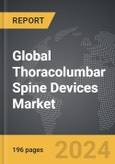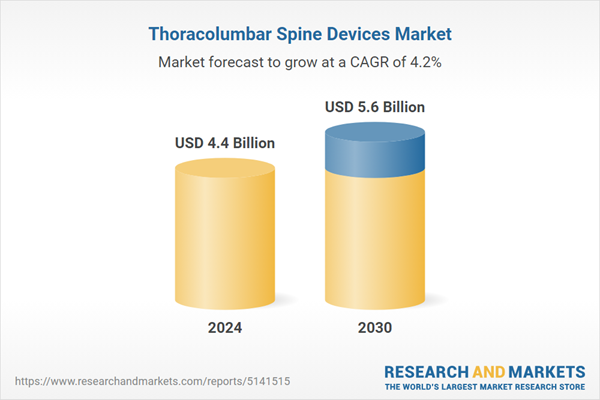Global Thoracolumbar Spine Devices Market - Key Trends and Drivers Summarized
Why Are Thoracolumbar Spine Devices in High Demand?
Thoracolumbar spine devices are critical medical implants used in the treatment of spinal disorders, deformities, trauma, and degenerative diseases affecting the thoracic and lumbar regions of the spine. These devices include spinal fusion implants, rods, screws, and motion-preserving devices that help stabilize the spine, reduce pain, and restore mobility to patients. The increasing prevalence of spinal disorders, particularly among the aging population, has driven the demand for thoracolumbar spine devices. With advancements in minimally invasive surgical techniques, these devices are becoming more sophisticated, offering improved patient outcomes, reduced recovery times, and fewer complications. As the global population continues to age, the need for effective treatment options for spinal disorders is growing, making thoracolumbar spine devices a crucial segment in the medical devices market.How Is the Thoracolumbar Spine Devices Market Structured?
Product types include spinal fusion devices, non-fusion devices, and dynamic stabilization systems. Spinal fusion devices hold a significant share of the market, driven by their use in treating a wide range of degenerative spinal conditions. Surgery types include open surgery and minimally invasive surgery (MIS), with MIS growing in popularity due to its ability to reduce patient trauma and recovery time. End-users include hospitals, specialized spine clinics, and ambulatory surgery centers. Hospitals remain the dominant end-user segment, but the rise of outpatient surgery centers is also driving demand for minimally invasive thoracolumbar spine devices.What Are the Key Trends in Thoracolumbar Spine Devices?
Technological advancements are shaping the thoracolumbar spine devices market, with innovations in 3D printing and robotics leading the way. The development of personalized, 3D-printed spinal implants is revolutionizing treatment by offering customized solutions tailored to individual patient anatomy. Robotics and navigation systems are also enhancing surgical precision, particularly in minimally invasive procedures, which are becoming more common as surgeons seek to reduce patient recovery times and improve outcomes. Furthermore, the growing focus on motion preservation technology, which aims to maintain the natural movement of the spine while alleviating pain, is driving the development of non-fusion devices. These trends are expanding the range of treatment options available to patients and improving the overall effectiveness of spinal surgeries.What Factors Are Driving Growth in the Thoracolumbar Spine Devices Market?
The growth in the thoracolumbar spine devices market is driven by several factors, including the increasing prevalence of spinal disorders, advancements in minimally invasive surgery, and the rising demand for personalized spinal implants. The growing aging population is a significant driver, as elderly individuals are more prone to spinal conditions such as degenerative disc disease and spinal stenosis. The shift towards minimally invasive techniques is also contributing to market growth, as patients seek procedures that offer faster recovery and less post-operative pain. Additionally, technological innovations such as 3D printing and robotic-assisted surgery are enhancing the precision and effectiveness of spinal treatments, further boosting demand for advanced thoracolumbar spine devices.Report Scope
The report analyzes the Thoracolumbar Spine Devices market, presented in terms of market value (US$ Thousand). The analysis covers the key segments and geographic regions outlined below.- Segments: Product Type (Implants & instrumentation, Spine Biologics); End-Use (Hospitals, Ambulatory Surgery Centers).
- Geographic Regions/Countries:World; United States; Canada; Japan; China; Europe (France; Germany; Italy; United Kingdom; Spain; Russia; and Rest of Europe); Asia-Pacific (Australia; India; South Korea; and Rest of Asia-Pacific); Latin America (Argentina; Brazil; Mexico; and Rest of Latin America); Middle East (Iran; Israel; Saudi Arabia; United Arab Emirates; and Rest of Middle East); and Africa.
Key Insights:
- Market Growth: Understand the significant growth trajectory of the Implants & Instrumentation segment, which is expected to reach US$4.2 Billion by 2030 with a CAGR of a 3.5%. The Spine Biologics segment is also set to grow at 6.4% CAGR over the analysis period.
- Regional Analysis: Gain insights into the U.S. market, valued at $1.2 Billion in 2024, and China, forecasted to grow at an impressive 6.6% CAGR to reach $1.2 Billion by 2030. Discover growth trends in other key regions, including Japan, Canada, Germany, and the Asia-Pacific.
Why You Should Buy This Report:
- Detailed Market Analysis: Access a thorough analysis of the Global Thoracolumbar Spine Devices Market, covering all major geographic regions and market segments.
- Competitive Insights: Get an overview of the competitive landscape, including the market presence of major players across different geographies.
- Future Trends and Drivers: Understand the key trends and drivers shaping the future of the Global Thoracolumbar Spine Devices Market.
- Actionable Insights: Benefit from actionable insights that can help you identify new revenue opportunities and make strategic business decisions.
Key Questions Answered:
- How is the Global Thoracolumbar Spine Devices Market expected to evolve by 2030?
- What are the main drivers and restraints affecting the market?
- Which market segments will grow the most over the forecast period?
- How will market shares for different regions and segments change by 2030?
- Who are the leading players in the market, and what are their prospects?
Report Features:
- Comprehensive Market Data: Independent analysis of annual sales and market forecasts in US$ Million from 2024 to 2030.
- In-Depth Regional Analysis: Detailed insights into key markets, including the U.S., China, Japan, Canada, Europe, Asia-Pacific, Latin America, Middle East, and Africa.
- Company Profiles: Coverage of players such as DePuy Synthes, Globus Medical, Inc., Medtronic PLC, NuVasive, Inc., Stryker Corporation and more.
- Complimentary Updates: Receive free report updates for one year to keep you informed of the latest market developments.
Some of the 46 companies featured in this Thoracolumbar Spine Devices market report include:
- DePuy Synthes
- Globus Medical, Inc.
- Medtronic PLC
- NuVasive, Inc.
- Stryker Corporation
- Zimmer Biomet Holdings, Inc.
This edition integrates the latest global trade and economic shifts into comprehensive market analysis. Key updates include:
- Tariff and Trade Impact: Insights into global tariff negotiations across 180+ countries, with analysis of supply chain turbulence, sourcing disruptions, and geographic realignment. Special focus on 2025 as a pivotal year for trade tensions, including updated perspectives on the Trump-era tariffs.
- Adjusted Forecasts and Analytics: Revised global and regional market forecasts through 2030, incorporating tariff effects, economic uncertainty, and structural changes in globalization. Includes historical analysis from 2015 to 2023.
- Strategic Market Dynamics: Evaluation of revised market prospects, regional outlooks, and key economic indicators such as population and urbanization trends.
- Innovation & Technology Trends: Latest developments in product and process innovation, emerging technologies, and key industry drivers shaping the competitive landscape.
- Competitive Intelligence: Updated global market share estimates for 2025, competitive positioning of major players (Strong/Active/Niche/Trivial), and refined focus on leading global brands and core players.
- Expert Insight & Commentary: Strategic analysis from economists, trade experts, and domain specialists to contextualize market shifts and identify emerging opportunities.
Table of Contents
Companies Mentioned (Partial List)
A selection of companies mentioned in this report includes, but is not limited to:
- DePuy Synthes
- Globus Medical, Inc.
- Medtronic PLC
- NuVasive, Inc.
- Stryker Corporation
- Zimmer Biomet Holdings, Inc.
Table Information
| Report Attribute | Details |
|---|---|
| No. of Pages | 196 |
| Published | December 2025 |
| Forecast Period | 2024 - 2030 |
| Estimated Market Value ( USD | $ 4.4 Billion |
| Forecasted Market Value ( USD | $ 5.6 Billion |
| Compound Annual Growth Rate | 4.2% |
| Regions Covered | Global |









